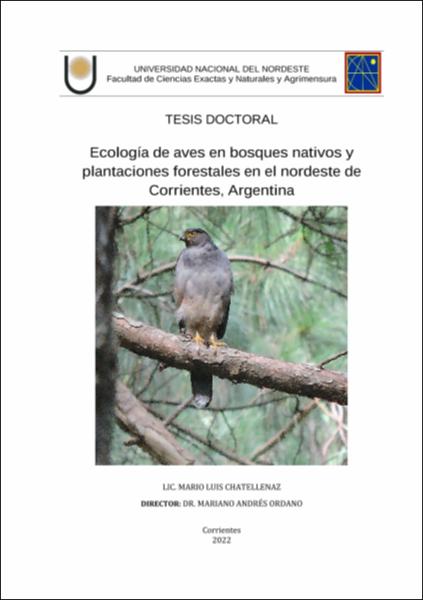Mostrar el registro sencillo del ítem
Ecología de aves en bosques nativos y plantaciones forestales en el nordeste de Corrientes, Argentina
| dc.contributor.advisor | Ordano, Mariano Andrés | |
| dc.contributor.author | Chatellenaz, Mario Luis | |
| dc.date.accessioned | 2023-05-18T14:36:33Z | |
| dc.date.available | 2023-05-18T14:36:33Z | |
| dc.date.issued | 2022 | |
| dc.identifier.citation | Chatellenaz, Mario Luis, 2022. Ecología de aves en bosques nativos y plantaciones forestales en el nordeste de Corrientes, Argentina. Tesis doctoral. Corrientes: Universidad Nacional del Nordeste. Facultad de Ciencias Exactas y Naturales y Agrimensura. | es |
| dc.identifier.uri | http://repositorio.unne.edu.ar/handle/123456789/51486 | |
| dc.description.abstract | El planeta se encuentra actualmente en un periodo sin precedentes de fuertes cambios globales productos de la actividad humana, al que muchos autores denominan Antropoceno. Las necesidades de una población creciente han conducido a una mayor presión de las actividades productivas sobre los ecosistemas naturales, que son la fuente de recursos para el ser humano. Entre las principales actividades productivas del cono sur sudamericano, particularmente el nordeste de Corrientes, las forestaciones de Pinus y Eucalyptus son prevalentes y de gran importancia en la economía regional. Es conocido que las forestaciones causan impactos negativos sobre la biodiversidad. No obstante, las forestaciones varían en el tipo de manejo de acuerdo al destino y proceso productivo, lo cual abre la posibilidad de evaluar cuáles condiciones de manejo minimizan los impactos sobre la biodiversidad en las forestaciones. En los últimos años, investigaciones desarrolladas en varios continentes han puesto de manifiesto que las forestaciones poseen cierta capacidad de servir como hábitat de un amplio rango de organismos, desde hongos a plantas vasculares, y desde artrópodos a mamíferos. Dependiendo del manejo que se haga de ellas, pueden convertirse en sitios relativamente valiosos para la conservación de la biodiversidad regional y el mantenimiento de procesos ecológicos en el paisaje. En Argentina, a pesar de la importancia de la superficie ocupada por las plantaciones forestales (1 321 912 ha), son escasos los estudios que evalúen los efectos del manejo sobre la biodiversidad, más aún en la provincia de Corrientes, que con 482 215 ha de pinos y eucaliptos, ocupa el primer lugar entre las provincias dedicadas a esta actividad en el país. Por ello, el principal objetivo de este trabajo fue examinar la variación en la diversidad de aves en bosques nativos y plantaciones de árboles exóticos en el nordeste de Corrientes, en función del tipo de manejo, uso de la tierra, y la composición y estructura de los ensambles de plantas y de la estructura de la vegetación. El estudio se llevó a cabo en predios del Grupo Las Marías, situados 7 km al sur de la localidad de Gobernador Virasoro (departamento Santo Tomé, Corrientes, Argentina). Para la descripción y caracterización de la vegetación, se seleccionaron rodales de Selva Paranaense (en adelante, bosque nativo, BN) y otros de plantaciones de pinos y eucaliptos, con y sin sotobosque de especies leñosas nativas (PCS, ECS, PSS y ESS, respectivamente). En cada una de estas cinco unidades ambientales se marcaron 10 parcelas de 50 x 2 m, en las cuales se registraron todas las especies de plantas leñosas con un diámetro a la altura del pecho (DAP) mayor o igual a 5 cm. Se registraron las especies presentes, forma de crecimiento, diámetro a la altura del pecho (DAP) y altura. Las variables consideradas fueron riqueza, abundancia, diversidad (índice de Shannon-Wiener), equitatividad, densidad y dominancia. Para estimar la diversidad y comparar la riqueza, composición y estructura del ensamble de aves en BN, plantaciones de PCS, ECS, PSS y ESS, se utilizó la técnica de conteos por puntos. En cada una de las unidades ambientales se establecieron puntos de conteo ubicados sistemáticamente cada 250-300 m. En cada uno de los puntos se registraron todas las aves vistas u oídas en un radio de 50 m, durante 10 minutos. Los conteos fueron realizados entre el amanecer y las cuatro horas siguientes, siempre en condiciones de buen tiempo, y sólo durante las estaciones de primavera y verano. Las especies de aves fueron categorizadas en grupos funcionales según su dieta, a través de consulta bibliográfica. Las variables consideradas en cada caso fueron riqueza, abundancia, diversidad (índice de Shannon-Wiener) y equitatividad. Tanto en el caso del ensamble de plantas como el de aves, para comparar la diversidad entre los ambientes, se construyeron curvas de extrapolación, que permiten estimar el número de especies habiendo considerado el muestreo disponible. Para el caso de las aves, se generaron además perfiles de diversidad. Para comparar entre ambientes las variables riqueza, abundancia, diversidad y equitatividad, se aplicaron análisis de varianza paramétricos y no paramétricos. La composición florística y la del ensamble de aves en los distintos ambientes fueron comparadas mediante la técnica de Escalamiento Multidimensional No Métrico (NMDS) y análisis permutacional de la varianza (PERMANOVA). Fueron registradas en total 58 especies de plantas correspondientes a 27 familias. El BN presentó la mayor riqueza de plantas (41 especies, 71% del total), seguido por el ECS (26 especies), mientras el ESS presentó la menor riqueza (1 especie). La riqueza media, abundancia media, diversidad, equitatividad y densidad fueron mayores en el BN, ubicándose en segundo lugar los ECS y PCS. Los valores significativamente más bajos para estas variables se obtuvieron en las forestaciones sin sotobosque. La mayor dominancia (expresada en m2 de troncos por unidad de superficie), se encontró en los pinales sin sotobosque. Si consideramos la forma de crecimiento o crecimiento (árbol o arbusto), el porcentaje de especies arbóreas, fue notoriamente mayor que las arbustivas (87% en el PCS y 92% en el ECS). En el BN predominó el número de especies esciófilas (60%), mientras que en las forestaciones con sotobosque la proporción de especies heliófilas fue mayor o aproximadamente similar a las esciófilas (67% en el PCS y 46% en el ECS). Esto podría ser consecuencia del manejo de las forestaciones mediante poda y raleo, que al abrir el dosel permiten mayor ingreso de luz, favoreciendo a las plantas heliófilas. En cuanto a los mecanismos de dispersión, las especies zoócoras predominaron en todas las unidades ambientales, constituyendo entre 75 y 100% del total en cada uno. El NMDS basado en la ocurrencia de las especies de plantas luego de la remoción de las especies de pinos y eucaliptos, mostró que la composición florística entre los ambientes estudiados fue significativamente diferente entre sí, particularmente la composición y estructura del BN. En lo que respecta al ensamble de aves, en 155 conteos por puntos se registró un total de 742 individuos correspondientes a 63 especies de aves. La mayor riqueza específica total se registró en el BN, con 41 especies (67%), seguido por el PCS con 39 especies. La menor riqueza se halló en los ESS, con apenas siete especies. El PCS y el ESS que, en ese orden, fueron los que evidenciaron mayor riqueza media y abundancia media y diversidad después del BN. Las plantaciones sin sotobosque, por el contrario, tuvieron los valores más bajos para estas variables, llegando a cero para diversidad según el índice de Shannon-Wiener, aunque su equitatividad fue mayor. En congruencia con ello, las curvas de extrapolación señalaron un incremento casi nulo de la diversidad si se duplicara el esfuerzo de muestreo en estos ambientes. Los grupos funcionales y la estructura del ensamble variaron entre BN y forestaciones con sotobosque variaron entre sí, siendo el eucaliptal con sotobosque el más distinto. Se sugiere que la existencia de sotobosque en las forestaciones se debería a la combinación de estos dos factores: posibilidad de llegada de diásporas de especies nativas, procedentes de una fuente cercana, y las condiciones del manejo forestal (poda y raleo), ya que al abrir claros que permiten la llegada de la luz hasta el suelo, brinda condiciones propicias a la regeneración de algunas especies de árboles y arbustos nativos en los monocultivos, incluyendo a especies consideradas en alguna categoría de amenaza. La existencia de sotobosque confiere a las plantaciones forestales una mayor complejidad estructural, y una oferta de recursos de importancia para las aves. Los resultados obtenidos sugieren que los bosques nativos, por su aporte en riqueza y diversidad a la región, deberían estar protegidos, mientras que la condición más propicia para el mantenimiento de la diversidad en las forestaciones son las que permiten el crecimiento de sotobosque. Teniendo en cuenta el incremento sostenido de las plantaciones forestales en los últimos años, y las presiones productivas de la región, este estudio sugiere vías de investigación para la minimización de impactos de las forestaciones y la valoración de la diversidad en ambientes productivos. | es |
| dc.description.abstract | The increase of the human population and the consequent impact on the planet has led to a series of strong global changes, known as the Anthropocene. The needs of a growing population have led to greater pressure from productive activities on natural ecosystems, which are the source of resources for humans. Among the main productive activities of the region, particularly the northeast of Corrientes, the afforestation of Pinus and Eucalyptus are prevalent and of great importance in the regional economy. It is known that afforestation causes negative impacts on biodiversity. However, afforestation varies in the type of management according to the destination and production process, which opens the possibility of assessing which management conditions minimize the impacts on diversity within the afforestation. In recent years, research carried out on several continents has shown that afforestation has some capacity to serve as a habitat for a wide range of organisms, from fungi to vascular plants, and from arthropods to mammals, and depending on the management that is done of these, they can become relatively valuable sites for the conservation of regional biodiversity and the maintenance of ecological processes in the landscape. In Argentina, despite the importance of the area occupied by forest plantations (1 321 912 ha), few studies assess the effects of management on biodiversity, even more so in the province of Corrientes, than with 482 215 ha of pines and eucalyptus, occupies the first place among the provinces dedicated to this activity in the country. Therefore, the main objective of this work was to examine the variation in the diversity of birds in native forests and exotic tree plantations in the northeast of Corrientes, depending on the type of management, land use, and the composition and structure of the assemblies of plants and the structure of vegetation. The study was carried out in properties of the Grupo Las Marías, located 7 km south of Gobernador Virasoro (department Santo Tomé, Corrientes, Argentina). For the description and characterization of the vegetation, stands of Paranaense Forest (hereafter native forest, BN) and others of pine and eucalyptus plantations were selected, with and without understorey of native woody species (PCS, ECS, PSS, and ESS, respectively). In each of these five environmental units, 10 plots of 50 x 2 m were marked, in which all species of woody plants with a diameter at breast height (DBH) greater than or equal to 5 cm were recorded. The species present, growth form, DBH, and height were recorded. The variables considered were richness, abundance, diversity (Shannon-Wiener index), equity, density, and dominance. Second, to estimate the diversity and compare the richness, composition, and structure of the bird assembly in BN, PCS, ECS, PSS, and ESS plantations, the point-counting technique was used. In each of the environmental units, counting points were established systematically located every 250-300 m. In each of the points, all the birds seen or heard were recorded within a radius of 50 m, for 10 minutes. The counts were made between dawn and the next four hours, always in good weather conditions, and only during the spring and summer seasons. Bird species were categorized into functional groups according to their diet, through bibliographic consultation. The variables considered in each case were richness, abundance, diversity (Shannon-Wiener index) and evenness. Both in the case of the assembly of plants and that of birds, to compare the diversity between the environments, extrapolation curves were constructed, which allow estimating the number of species having considered the available sampling. In the case of birds, diversity profiles were also generated. To compare the variables richness, abundance, diversity, and evenness between environments, parametric and non-parametric analysis of variance were applied. The floristic composition and that of the bird assembly in the different environments were compared using the Non-Metric Multidimensional Scaling (NMDS) technique and permutational analysis of variance (PERMANOVA). A total of 58 plant species corresponding to 27 families were registered. The BN presented the highest richness of plants (41 species, 71% of the total), followed by the ECS (26 species), while the ESS presented the lowest richness (1 species). The average richness, average abundance, diversity, evenness, and density were higher in the BN, placing ECS and PCS in second place. Significantly lower values for these variables were obtained in afforestation without understorey. The greatest dominance (expressed in m2 of logs per unit area), was found in the pinewoods without understorey. If we consider the way of life or growth (tree or shrub), the percentage of tree species was notoriously higher than the bushes (87% in the PCS and 92% in the ECS). In BN, the number of sciophilous species predominated (60%), while in forests with understorey, the proportion of heliophilous species was greater or approximately similar to the sciophilous (67% in the PCS and 46% in the ECS). This could be a consequence of the management of afforestation by pruning and thinning, which by opening the canopy allows greater light entry, favoring heliophilous plants. As for the dispersal mechanisms, zoochorous species predominated in all environments, constituting between 75 and 100% of the total in each. The NMDS based on the occurrence of plant species after the removal of pine and eucalyptus species showed that the floristic composition between the studied environments was significantly different from each other, particularly the composition and structure of the BN. Concerning the assembly of birds, in 155-point counts, a total of 742 individuals corresponding to 63 species of birds were recorded. The highest specific richness was recorded in the BN, with 41 species (67%), followed by the PCS with 39 species. The lowest richness was found in the ESS, with just seven species. The PCS and the ESS, which, in that order, showed the highest average richness and average abundance and diversity after the BN. Plantations without understorey, on the other hand, had the lowest values for these variables, reaching zero for diversity according to the Shannon-Wiener index, although their equity was greater. Consistent with this, extrapolation curves indicated an almost zero increase in diversity if the sampling effort in these environments were doubled. The functional groups and the structure of the assembly varied between BN and understorey afforestation varied among themselves, with the eucalyptus with understorey being the most distinct. It is suggested that the existence of understorey in forestry should be due to the combination of these two factors: possibility of arrival of propagules of native species, from a nearby source, and forest management conditions (pruning and thinning), since opening clearings that allow the arrival of light to the ground, provides conditions conducive to the regeneration of some species of native trees and shrubs in monocultures, including species considered in some category of threat. The existence of understorey gives forest plantations greater structural complexity, and an offer of resources of importance to birds. The results obtained suggest that native forests, due to their contribution in richness and diversity to the region, should be protected, while the most favorable condition for the maintenance of diversity in afforestation are those that allow the growth of understorey. Taking into account the sustained increase in forest plantations in recent years, and the productive pressures of the region, this study suggests avenues of research for the minimization of impacts of afforestation and the valuation of diversity in productive environments. | es |
| dc.format | application/pdf | es |
| dc.format.extent | 117 p. | es |
| dc.language.iso | spa | es |
| dc.publisher | Universidad Nacional del Nordeste. Facultad de Ciencias Exactas y Naturales y Agrimensura | es |
| dc.rights | openAccess | es |
| dc.rights.uri | http://creativecommons.org/licenses/by-nc-nd/2.5/ar/ | es |
| dc.subject | Ecología de aves | es |
| dc.subject | Bosques nativos | es |
| dc.subject | Plantaciones forestales | es |
| dc.subject | Ciencias biológicas | es |
| dc.subject | Corrientes (Argentina) | es |
| dc.title | Ecología de aves en bosques nativos y plantaciones forestales en el nordeste de Corrientes, Argentina | es |
| dc.type | Tesis doctoral | es |
| unne.affiliation | Fil: Chatellenaz, Mario Luis. Universidad Nacional del Nordeste. Facultad de Ciencias Exactas y Naturales y Agrimensura; Argentina. | es |
| unne.affiliation | Fil: Ordano, Mariano Andrés. Consejo Nacional de Investigaciones Científicas y Técnicas. Instituto de Ecología Regional; Argentina. | es |
| unne.affiliation | Fil: Ordano, Mariano Andrés. Consejo Nacional de Investigaciones Científicas y Técnicas. Centro Científico Tecnológico; Argentina. | es |
| unne.description.grado | Doctor en Biología | es |
Ficheros en el ítem
Este ítem aparece en la(s) siguiente(s) colección(ones)
-
Tesis doctoral [105]





